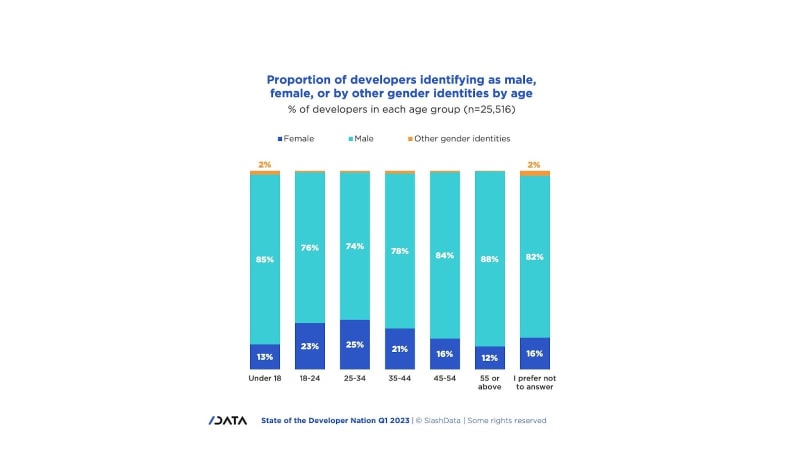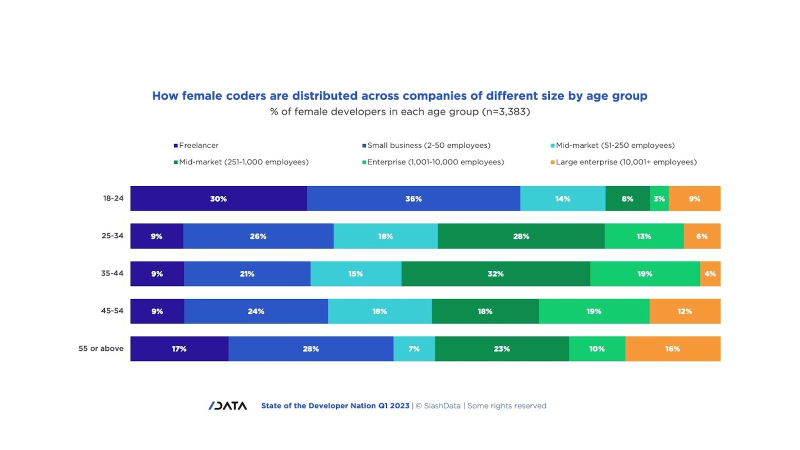Since the beginning of computing, women have consistently played a pivotal role in software development that has frequently been overlooked; from Ada Lovelace developing the first algorithms for modern computers to Margaret Hamilton’s crucial role in the development of on-board guidance software for NASA’s Apollo program.
However, despite women’s exceptional contributions to the field, they have often received less credit than their male counterparts, and their place in the field is questioned.
Today, efforts are being made across the software development ecosystem to address these historical biases. While efforts have been made to promote women to get involved in the historically male-dominated field, there is still considerable work to be done.
Data and technology are not free from bias. Past applications and software development projects have demonstrated the need for input from diverse groups2.
In this chapter, we specifically explore the involvement of women in software development. According to our latest global developer survey (Q1 2023), nearly a quarter of all developers (22%) self-identify as females, the highest proportion since we began asking respondents about their gender.
This is a small increase from two years ago, since Q1 2021, when female coders accounted for 19% of all developers.
This slight increase in the proportion of developers self-identifying as females can be partially attributed to the rise in the representation of women among early-to-mid-career developers. Women currently make up a quarter (25%) of developers between the ages of 25 and 34, the highest proportion of all age groups, up from less than 20% in Q1 2021.
This is followed closely by 23% of developers between the ages of 18 and 24. The highest proportion of women falling within the 25-34 age bracket indicates the possible beginning of a positive trend for the future of women in the tech industry. This is the age when people begin to settle into their careers and is a point where people are likely to develop additional skills that allow them to cross-train and enter industries of their choosing.
Further to this, we are also seeing an increasing presence of women in certain regions that are leading to an increase in the proportion of women in technology overall.
Specific highlights include the Middle East and Africa, where the proportion of women in technology in this region has gone from 10% in Q1 2021 to over 20% currently. Similarly, women made up 15% of developers in East Asia in Q1 2021 and now makeup almost 30% of developers.
Overall, a higher representation of women in the software development ecosystem is a great development. Not only do they bring critical perspectives and approaches to the work being undertaken, but diversity in the workforce offers fresh experiences that can help businesses address underserved needs.
It also enhances efforts to make spaces that are less hostile to women in both overt and subtle ways, allowing even more women to follow their interests in the technology space.
The proportion of women among developers varies substantially depending on the types of projects they are involved in. Virtual reality (VR) and augmented reality (AR) projects have the highest proportion of women, at 33% and 28% respectively, followed by games (28%).
On the contrary, backend services and web application projects have the lowest concentration of female coders, at just 13% and 16%, respectively.
With these sectors selecting those with formal degrees at higher rates than other areas, and a 10 percentage point difference between men and women having such a degree, this may be one factor in the lower presence of women.
Undergraduate degrees in computer science or equivalent are held by 45% of backend developers and 43% of web developers, compared to 37% of all developers.
Further, the lower proportion of women working in backend services and web application development may, in part, be attributed to the historically male-dominated culture within these sectors. Addressing cultural differences3 and fostering a more inclusive atmosphere can contribute to balancing representation and mentorship opportunities within these sectors.
Further, there may be potential unconscious biases in hiring practices derived from existing workplace culture, which may prevent certain development areas from harnessing the full spectrum of talent, and benefit from the input of individuals with diverse backgrounds.
Examining the sizes of organisations that female developers work for throughout various stages of their life and career could indicate that company characteristics have an influence on women’s decisions in the technology sector.
Like young men, young women are more likely to work as freelancers relative to other age groups and only return to similar proportions among developers aged 55 and above. Additionally, younger female developers (18-24) tend to work for smaller companies, whereas older female developers (45+) are more inclined to work for larger organisations with over 10,000 employees.
Examining a particular age group, women between the age of 35 and 44, may offer an insight into issues women have with progressing through their careers. Previous research into women’s careers in the software development sector has highlighted that women are promoted at a lower rate than men4.
However, when looking at the roles women self-identify with, we find that at mid-market companies (251-1,000 employees) and enterprises (1,001-10,000 employees) the percentage of women in management positions (20% and 29%) is significantly higher than at other organisation sizes (13% on average).
These organisations could offer better opportunities for career growth, decision-making, and leadership. In larger companies, management roles might be more hierarchical and bureaucratic, leading to less autonomy and slower career progression.
In smaller companies, limited opportunities due to their size might result in fewer leadership positions being available overall, and with women being a minority in software development, there are fewer women in leadership positions.
Further, there is an underrepresentation of women in certain leadership roles. 11% of men list their role as CIO, CTO, or IT manager, and 14% identify as technical team leads, compared to just 9% and 8% of women. This could create a cycle whereby there may be fewer mentorship opportunities for other women.
When there are fewer female leaders, it has been found in a range of fields5 that it can be harder for women to progress in their careers, and it can be more challenging for aspiring women to find mentors who can guide them, provide valuable insights, and help them navigate their career paths.
However, while still a minority of those in such roles, 25% of those in CEO or management positions are women, compared to their position as 22% of the developer population.
While only a small percentage difference, given their underrepresentation in other leadership roles, this represents an area where women are getting leadership positions. Among the previously discussed issues women may face, women are also less likely to apply for leadership positions where they do not fulfil all of the requirements than men6.
This may be leading women to also self-select towards management positions that are not solely dependent on technical skills.
The observation that women hold a higher proportion of CEO/management roles compared to men (7% against 5%, respectively), particularly in companies with more than 250 employees (8% of women to 4% of men), could indicate a positive shift in gender representation and diversity in leadership positions.
This trend might be driven by a changing corporate culture that is increasingly recognising the importance of gender diversity in leadership, leading companies to seek out and promote women into these roles6 proactively.
Embracing diverse perspectives at the decision-making level can result in better organisational performance and decision-making.
Another factor that may contribute to this observation is the growing appreciation for women’s leadership styles, which tend to be more collaborative, participative, and relationship-oriented. These qualities are often valued in today’s business environment and might make women particularly well-suited for CEO/management roles.
Moreover, women, through their skills and abilities, are likely actively contributing to this positive trend, demonstrating that they are well-equipped for leadership roles. Despite women remaining a minority in leadership this growing representation in CEO/management roles is a step in the right direction, highlighting the benefits of diverse and inclusive leadership.
Want to contribute to data such as the above?
Take the latest wave of our developer nation survey here!









Top comments (0)